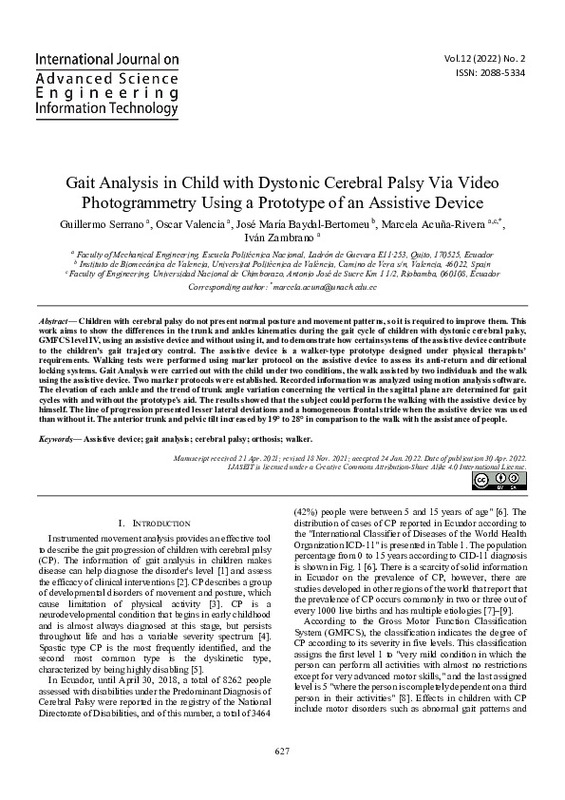JavaScript is disabled for your browser. Some features of this site may not work without it.
Buscar en RiuNet
Listar
Mi cuenta
Estadísticas
Ayuda RiuNet
Admin. UPV
Gait Analysis in Child with Dystonic Cerebral Palsy Via Video Photogrammetry Using a Prototype of an Assistive Device
Mostrar el registro sencillo del ítem
Ficheros en el ítem
| dc.contributor.author | Serrano, Guillermo
|
es_ES |
| dc.contributor.author | Valencia, Oscar
|
es_ES |
| dc.contributor.author | Baydal Bertomeu, José Mª
|
es_ES |
| dc.contributor.author | Acuña-Rivera, Marcela
|
es_ES |
| dc.contributor.author | Zambrano, Iván
|
es_ES |
| dc.date.accessioned | 2023-11-07T19:02:38Z | |
| dc.date.available | 2023-11-07T19:02:38Z | |
| dc.date.issued | 2022-04-30 | es_ES |
| dc.identifier.issn | 2088-5334 | es_ES |
| dc.identifier.uri | http://hdl.handle.net/10251/199456 | |
| dc.description.abstract | [EN] Children with cerebral palsy do not present normal posture and movement patterns, so it is required to improve them. This work aims to show the differences in the trunk and ankles kinematics during the gait cycle of children with dystonic cerebral palsy, GMFCS level IV, using an assistive device and without using it, and to demonstrate how certain systems of the assistive device contribute to the children¿s gait trajectory control. The assistive device is a walker-type prototype designed under physical therapists¿ requirements. Walking tests were performed using marker protocol on the assistive device to assess its anti-return and directional locking systems. Gait Analysis were carried out with the child under two conditions, the walk assisted by two individuals and the walk using the assistive device. Two marker protocols were established. Recorded information was analyzed using motion analysis software. The elevation of each ankle and the trend of trunk angle variation concerning the vertical in the sagittal plane are determined for gait cycles with and without the prototype's aid. The results showed that the subject could perform the walking with the assistive device by himself. The line of progression presented lesser lateral deviations and a homogeneous frontal stride when the assistive device was used than without it. The anterior trunk and pelvic tilt increased by 19° to 28° in comparison to the walk with the assistance of people. | es_ES |
| dc.language | Inglés | es_ES |
| dc.publisher | Indonesian Society for Knowledge and Human Development | es_ES |
| dc.relation.ispartof | International Journal on Advanced Science, Engineering and Information Technology | es_ES |
| dc.rights | Reconocimiento - Compartir igual (by-sa) | es_ES |
| dc.subject | Assistive device | es_ES |
| dc.subject | Gait analysis | es_ES |
| dc.subject | Cerebral palsy | es_ES |
| dc.subject | Orthosis | es_ES |
| dc.subject | Walker | es_ES |
| dc.title | Gait Analysis in Child with Dystonic Cerebral Palsy Via Video Photogrammetry Using a Prototype of an Assistive Device | es_ES |
| dc.type | Artículo | es_ES |
| dc.identifier.doi | 10.18517/ijaseit.12.2.15294 | es_ES |
| dc.rights.accessRights | Abierto | es_ES |
| dc.contributor.affiliation | Universitat Politècnica de València. Instituto Universitario Mixto de Biomecánica de Valencia - Institut Universitari Mixt de Biomecànica de València | es_ES |
| dc.description.bibliographicCitation | Serrano, G.; Valencia, O.; Baydal Bertomeu, JM.; Acuña-Rivera, M.; Zambrano, I. (2022). Gait Analysis in Child with Dystonic Cerebral Palsy Via Video Photogrammetry Using a Prototype of an Assistive Device. International Journal on Advanced Science, Engineering and Information Technology. 12(2):627-635. https://doi.org/10.18517/ijaseit.12.2.15294 | es_ES |
| dc.description.accrualMethod | S | es_ES |
| dc.relation.publisherversion | https://doi.org/10.18517/ijaseit.12.2.15294 | es_ES |
| dc.description.upvformatpinicio | 627 | es_ES |
| dc.description.upvformatpfin | 635 | es_ES |
| dc.type.version | info:eu-repo/semantics/publishedVersion | es_ES |
| dc.description.volume | 12 | es_ES |
| dc.description.issue | 2 | es_ES |
| dc.relation.pasarela | S\489219 | es_ES |








